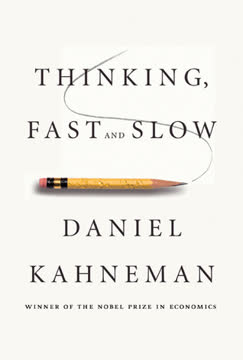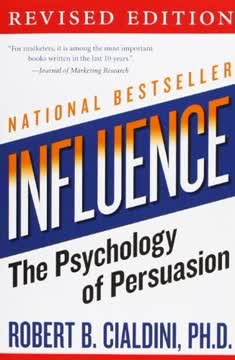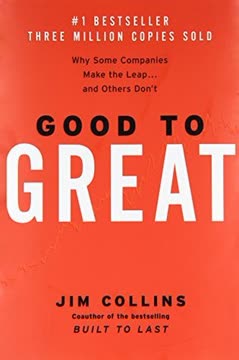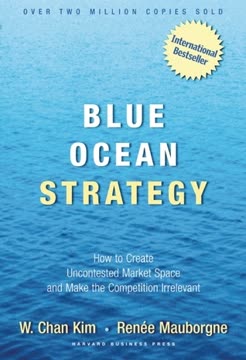Key Takeaways
1. Create uncontested market space by redefining industry boundaries
Blue oceans denote all the industries not in existence today. This is the unknown market space.
Redefine competition. Instead of competing in existing market space (red oceans), companies can create new market space (blue oceans) where competition is irrelevant. This involves looking across alternative industries, strategic groups, buyer groups, complementary products/services, functional-emotional orientation, and even time to reconstruct market boundaries.
Challenge industry assumptions. Blue ocean strategy requires breaking free from accepted industry norms and competitive benchmarking. By questioning fundamental assumptions about how an industry operates, companies can discover innovative ways to create value for customers.
Examples of blue ocean creation:
- Cirque du Soleil reinvented circus by combining elements of theater and circus
- [yellow tail] wines created a new market by simplifying wine for casual drinkers
- Nintendo Wii redefined gaming by focusing on simple, intuitive motion controls
2. Focus on the big picture, not the numbers, to develop strategy
The strategic profile with high blue ocean potential has three complementary qualities: focus, divergence, and a compelling tagline.
Visualize strategy. Use the strategy canvas tool to capture the current state of play in the known market space and visualize potential new strategies. This provides a graphic depiction of a company's relative performance across key competing factors in its industry.
Pursue differentiation and low cost. Blue ocean strategy seeks to break the value-cost trade-off by pursuing both differentiation and low cost simultaneously. This is achieved by eliminating and reducing factors an industry competes on, while raising and creating factors the industry has never offered.
Four actions framework:
- Eliminate: Which factors should be eliminated?
- Reduce: Which factors should be reduced well below the industry's standard?
- Raise: Which factors should be raised well above the industry's standard?
- Create: Which factors should be created that the industry has never offered?
3. Reach beyond existing demand to unlock new markets
To maximize the size of their blue oceans, companies need to take a reverse course. Instead of concentrating on customers, they need to look to noncustomers.
Look beyond current customers. Rather than focusing on existing customers and finer segmentation, companies should look to noncustomers to unlock new demand. This involves understanding why non-customers don't buy from the industry and addressing their needs.
Focus on commonalities. Instead of focusing on customer differences and customization, build on powerful commonalities in what buyers value. This allows companies to reach beyond existing demand to attract new masses of customers.
Three tiers of noncustomers:
- "Soon-to-be" noncustomers who are on the edge of the market
- "Refusing" noncustomers who consciously choose against the market
- "Unexplored" noncustomers in distant markets
4. Get the strategic sequence right for sustainable business models
A company is not only top management, nor is it only middle management. A company is everyone from the top to the front lines.
Follow the right sequence. To create a viable blue ocean strategy, follow this sequence: 1) Exceptional utility for buyers, 2) Strategic pricing to ensure mass appeal, 3) Target costing to ensure healthy profit margins, 4) Addressing adoption hurdles.
Ensure profitability. A blue ocean strategy must deliver value to buyers, the company, and its partners. Use target costing to ensure profitability, and consider new pricing models if necessary to hit the strategic price point.
Key questions for each step:
- Utility: Is there exceptional buyer utility?
- Price: Is it easily accessible to the mass of buyers?
- Cost: Can you attain your cost target to profit at your strategic price?
- Adoption: Have you addressed adoption hurdles upfront?
5. Overcome organizational hurdles to execute blue ocean strategy
Tipping point leadership allows you to overcome these four hurdles fast and at low cost while winning employees' backing in executing a break from the status quo.
Identify key hurdles. Executing blue ocean strategy requires overcoming four key organizational hurdles: cognitive, resource, motivational, and political. Use tipping point leadership to overcome these hurdles quickly and at low cost.
Focus on disproportionate influence. Instead of trying to mount a massive challenge, focus on identifying and leveraging factors of disproportionate influence in an organization. This allows for rapid, low-cost implementation of new strategies.
Tipping point leadership tactics:
- Break through the cognitive hurdle by highlighting the need for change
- Jump the resource hurdle by concentrating resources on key areas
- Jump the motivational hurdle by focusing on key influencers
- Knock over the political hurdle by silencing internal opponents and leveraging allies
6. Build execution into strategy through fair process
To build people's trust and commitment deep in the ranks and inspire their voluntary cooperation, companies need to build execution into strategy from the start.
Emphasize fair process. To build trust, commitment, and voluntary cooperation in executing strategy, companies must practice fair process. This involves engaging people in strategic decisions, explaining the rationale behind decisions, and setting clear expectations.
Align hearts and minds. Fair process helps align people's hearts and minds with the new strategy, encouraging them to go beyond compulsory execution to voluntary cooperation. This is crucial for successful implementation of blue ocean strategies.
Three E principles of fair process:
- Engagement: Involving individuals in decisions that affect them
- Explanation: Ensuring everyone understands the rationale for decisions
- Expectation clarity: Clearly communicating new rules and expectations
7. Sustain and renew blue ocean strategy to maintain growth
Eventually, however, almost every blue ocean strategy will be imitated. As imitators try to grab a share of your blue ocean, you typically launch offenses to defend your hard-earned customer base.
Monitor value curves. Continuously monitor your value curve on the strategy canvas to identify when it's time to create a new blue ocean. When your value curve converges with competitors', it's time to value-innovate again.
Build barriers to imitation. Blue ocean strategies often come with natural barriers to imitation, such as brand image, patents, or network effects. Leverage these barriers to sustain your blue ocean for as long as possible.
Sustaining blue oceans:
- Dominate the blue ocean by continually improving and expanding your offering
- Make yourself a moving target for imitators
- Create multiple blue oceans from your initial success
- Innovate again when competitors begin to catch up
Last updated:
FAQ
What's Blue Ocean Strategy about?
- Creating Uncontested Market Space: Blue Ocean Strategy by W. Chan Kim focuses on creating new market spaces, termed "blue oceans," where competition is irrelevant.
- Value Innovation: It emphasizes value innovation, which involves simultaneously pursuing differentiation and low cost to create a leap in value for both the company and its customers.
- Strategic Frameworks: The book introduces tools like the strategy canvas and the four actions framework to help businesses systematically identify and pursue blue oceans.
Why should I read Blue Ocean Strategy?
- Innovative Business Insights: The book offers a fresh perspective on strategic thinking, encouraging businesses to move beyond traditional competition-focused strategies.
- Practical Tools and Frameworks: It provides actionable frameworks that can be applied across various industries, making it a valuable resource for business leaders.
- Real-World Success Stories: Numerous case studies, such as Cirque du Soleil and Southwest Airlines, illustrate the successful application of blue ocean strategies.
What are the key takeaways of Blue Ocean Strategy?
- Shift from Competing to Creating: Focus on creating new market spaces rather than competing in existing ones, redefining industry boundaries.
- Importance of Buyer Utility: Ensure offerings provide exceptional value to attract both existing customers and noncustomers.
- Strategic Sequence Matters: Follow a strategic sequence of buyer utility, price, cost, and adoption to ensure commercial viability of blue ocean ideas.
How does Blue Ocean Strategy define "value innovation"?
- Core Concept: Value innovation is the cornerstone of blue ocean strategy, focusing on making competition irrelevant by creating a leap in value.
- Differentiation and Low Cost: It involves pursuing both differentiation and low cost simultaneously, breaking the traditional value-cost trade-off.
- Real-World Examples: Companies like Cirque du Soleil achieved value innovation by redefining their industry offerings.
What is the strategy canvas in Blue Ocean Strategy?
- Visualizing Market Position: The strategy canvas is a diagnostic tool that visually captures the current state of play in the market.
- Identifying Key Factors: It helps companies plot key competitive factors and their relative performance, identifying gaps and opportunities for innovation.
- Facilitating Strategic Discussions: The canvas serves as a common reference point for evaluating and refining strategies.
What is the four actions framework in Blue Ocean Strategy?
- Eliminate, Reduce, Raise, Create: This framework consists of four key questions to help businesses rethink their offerings and reconstruct buyer value.
- Reconstruct Buyer Value: By addressing these questions, companies can offer new experiences that attract customers and differentiate themselves.
- Practical Application: The framework is designed to be applicable across various industries, identifying opportunities for value innovation.
What are the three tiers of noncustomers in Blue Ocean Strategy?
- First Tier - Soon-to-be Noncustomers: These are customers who minimally use current offerings and are ready to switch for better alternatives.
- Second Tier - Refusing Noncustomers: This group consciously avoids current offerings due to perceived inadequacies or high costs.
- Third Tier - Unexplored Noncustomers: Individuals who have never considered the industry’s offerings, representing untapped market potential.
How can companies reach beyond existing demand according to Blue Ocean Strategy?
- Focus on Noncustomers: Prioritize understanding and targeting noncustomers to identify latent demand.
- Identify Commonalities: Look for shared needs among noncustomers to create offerings that appeal to a broader audience.
- Avoid Over-Segmentation: Simplify value propositions to aggregate demand, leading to larger market opportunities.
What is the significance of getting the strategic sequence right in Blue Ocean Strategy?
- Ensuring Commercial Viability: The strategic sequence of buyer utility, price, cost, and adoption is crucial for ensuring blue ocean ideas are viable.
- Focus on Buyer Utility First: Assess whether the offering provides exceptional buyer utility before considering pricing and cost.
- Addressing Adoption Hurdles: Identify and address potential adoption hurdles upfront to ensure successful market implementation.
What are the six paths framework in Blue Ocean Strategy?
- Framework Overview: The six paths framework provides a systematic approach to discovering blue oceans by exploring different market dimensions.
- Path Examples: Includes looking across alternative industries and redefining the buyer group to uncover new opportunities.
- Strategic Insights: Helps companies identify opportunities for value innovation that may not be immediately apparent.
What are the barriers to imitation discussed in Blue Ocean Strategy?
- Operational Barriers: Factors like brand image conflict and natural monopolies prevent easy replication of blue ocean strategies.
- Cognitive Barriers: Conventional strategic logic often leads to ridicule of new ideas, slowing down imitation efforts.
- Long-Term Sustainability: These barriers contribute to the sustainability of blue oceans, maintaining competitive advantage.
How does Blue Ocean Strategy address the issue of execution?
- Strategic Sequence: Outlines a sequence including buyer utility, strategic pricing, and target costing for successful execution.
- Overcoming Organizational Hurdles: Discusses overcoming cognitive, resource, motivational, and political hurdles for effective implementation.
- Fair Process: Emphasizes fair process in building trust and commitment among employees, crucial for executing the strategy.
Review Summary
Blue Ocean Strategy receives mixed reviews. Many praise its innovative approach to creating uncontested market spaces and making competition irrelevant. Readers appreciate the practical frameworks and real-world examples provided. However, critics argue the concept is oversimplified and lacks novelty. Some find the book repetitive and lacking in substantial evidence. Despite these criticisms, many consider it a valuable read for business leaders and entrepreneurs seeking fresh perspectives on strategy and market creation.
Similar Books










Download PDF
Download EPUB
.epub digital book format is ideal for reading ebooks on phones, tablets, and e-readers.






